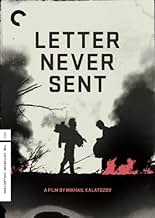PUNTUACIÓN EN IMDb
7,8/10
4,4 mil
TU PUNTUACIÓN
Cuatro geólogos buscan diamantes en el desierto de Siberia.Cuatro geólogos buscan diamantes en el desierto de Siberia.Cuatro geólogos buscan diamantes en el desierto de Siberia.
- Premios
- 1 nominación en total
Innokentiy Smoktunovskiy
- Konstantin Sabinin
- (as I. Smoktunovskiy)
Tatyana Samoylova
- Tanya
- (as T. Samoylova)
Vasiliy Livanov
- Andrey
- (as V. Livanov)
Evgeniy Urbanskiy
- Sergey Stepanovich
- (as Ye. Urbanskiy)
Galina Kozhakina
- Vera
- (as G. Kozhakina)
Argumento
¿Sabías que...?
- CuriosidadesIn 1995 the film was restored by and shown in United States upon the financial support from Francis Coppola.
- Citas
Andrey: Sergei, you've fallen in love with a girl who loves someone else, and that man loves her. From the moral standpoint it's wrong.
Sergey Stepanovich: I don't give a damn about your bookish morale. I'm in love.
Andrey: That's an egoist speaking.
- ConexionesFeatured in Fejezetek a film történetéböl: A szovjet film 1953-1970 (1990)
Reseña destacada
Welcome to Siberia, circa 1959 (in perfectly restored, glorious Black and White).
Although this story revolves around four 'pioneers' dropped into a vast wilderness to search for a rumored vein of diamonds (aka 'the Diamond Pipe'), the real star of the movie is cinematographer Sergei Urusevsky ("Soy Cuba," "The Cranes Are Flying").
Urusevsky is master of composition, dolly shots, and hand-held photography (when necessary). The way he frames his close-ups of the actors practically allows the audience to see into their souls.
Of course, it helps that he's shooting a top-notch Russian cast, including actress Tatyana Samojlova ("The Cranes Are Flying") whose character 'Tanya' is desperate to survive the troubling events that befall the group. Tanya is also the lone female and commands the attentions of two men in the rock-sampling group (though one is unrequited).
In addition, the visual elements are underscored aurally by composer Nikolai Kryukov's ("The Forty-first") evocative score, although he does amp up the music a bit too much in a couple of scenes. Not unusual for the time period, so set your appreciation meter back to the 50's and you won't be as bothered as I was.
The title of the film refers to not one but two letters that figure into the plot. One is a long, personal letter that is referred to in voice-over from time to time throughout the film, while the other is a love letter thought to be hidden away until it accidentally comes to light.
The plot is very straightforward so I won't spoil any surprises by detailing it here, suffice to say that the main attractions of this film are the artistic cinematography, the strong cast, and the director's choice to foreshadow plot elements by overlaying fiery images over his hardcharging trekkers.
If you've never seen any films by director Mikhail Kalatozov ("The Red Tent," "Soy Cuba," "The Cranes Are Flying"), then this one is probably as accessible as any and with a new restoration to boot, practically a MUST-SEE.
The ending alone is worth the price of admission, so check it out festival goers.
Although this story revolves around four 'pioneers' dropped into a vast wilderness to search for a rumored vein of diamonds (aka 'the Diamond Pipe'), the real star of the movie is cinematographer Sergei Urusevsky ("Soy Cuba," "The Cranes Are Flying").
Urusevsky is master of composition, dolly shots, and hand-held photography (when necessary). The way he frames his close-ups of the actors practically allows the audience to see into their souls.
Of course, it helps that he's shooting a top-notch Russian cast, including actress Tatyana Samojlova ("The Cranes Are Flying") whose character 'Tanya' is desperate to survive the troubling events that befall the group. Tanya is also the lone female and commands the attentions of two men in the rock-sampling group (though one is unrequited).
In addition, the visual elements are underscored aurally by composer Nikolai Kryukov's ("The Forty-first") evocative score, although he does amp up the music a bit too much in a couple of scenes. Not unusual for the time period, so set your appreciation meter back to the 50's and you won't be as bothered as I was.
The title of the film refers to not one but two letters that figure into the plot. One is a long, personal letter that is referred to in voice-over from time to time throughout the film, while the other is a love letter thought to be hidden away until it accidentally comes to light.
The plot is very straightforward so I won't spoil any surprises by detailing it here, suffice to say that the main attractions of this film are the artistic cinematography, the strong cast, and the director's choice to foreshadow plot elements by overlaying fiery images over his hardcharging trekkers.
If you've never seen any films by director Mikhail Kalatozov ("The Red Tent," "Soy Cuba," "The Cranes Are Flying"), then this one is probably as accessible as any and with a new restoration to boot, practically a MUST-SEE.
The ending alone is worth the price of admission, so check it out festival goers.
- SONNYK_USA
- 21 abr 2007
- Enlace permanente
Selecciones populares
Inicia sesión para calificar y añadir a tu lista para recibir recomendaciones personalizadas
- How long is Letter Never Sent?Con tecnología de Alexa
Detalles
- Duración1 hora 36 minutos
- Color
- Mezcla de sonido
- Relación de aspecto
- 1.37 : 1
Contribuir a esta página
Sugerir un cambio o añadir el contenido que falta

Principal laguna de datos
By what name was La carta que no se envió (1960) officially released in India in English?
Responde
























